A Gourmet’s Guide to Lismore - 1
The year is 1955 and 18yr old Harry Eric Crethar is doing his usual run around ‘The Block’, the local name for the major retail portion of Lismore’s CBD, sussing out the café competition in preparation for the launch of his very own ‘Wonder Bar.’
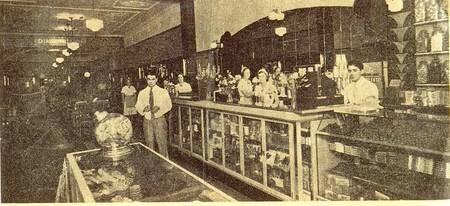
[Haralambos Anargyros Kritharis, Greek National Day 1955 Bexhill.]
He’s a happy chap; having survived the destruction of war-torn Athens and Piraeus he now sees comparative prosperity and optimism all around him. The whole community is still imbued with post war euphoria, building their dream homes in newly created subdivisions, acquiring cars and taking regular trips to the beach. The dairy farmers, still the mainstay of the local economy, albeit still struggling and propped up by ever increasing government subsidies, continue to believe that stabilization of their industry is just around the corner. The banana growers, in ever increasing numbers due to record profits, believe the current glut is only a temporary aberration. The old style department store tycoons and their army of employees believe the new self-service chain stores will never catch on. And all the other shop-keepers around the block have smiles on their faces as they look out their doorways and believe the huge crowds filing past will go on forever. The warnings of the weather prophets of storm clouds on the horizon and of the seismological diviners on ominous rumbles through the region go unnoticed except for a few astute Greeks who had started the exodus from Lismore post WW2. Nevertheless, the Greeks still dominate the catering trade and their subsequent fall from glory is for retrospective contemplation. In the meantime, young Harry, starting his circuit along Molesworth Street comes to his first port of call:
The Capitol Café (84 Molesworth)
Notwithstanding the groundwork of Athena Andrulakis (nee Florias), The Capitol, introduced into Lismore by the Vlismas Bros in 1929, was the first major Ithacan assault on the cafe stranglehold of the Kytherian mafia. It has swapped hands a few times and is now in the possession of Peter Manias and, except for being lined in black marble and the installation of a magnificent new soda fountain, remains unchanged from the extensive makeover of 1937, which brought it up to a standard to rival Angelo Crethar’s establishment further down the street. While they lack some of Angelo’s finer touches, wooden seating verses plush leather-covered cushions for instance, the wider street frontage gives the place more elbow room for indulgent dining and mod cons, leaving the adjudicators to award a marginal first in the competition for Lismore’s classiest restaurant (or as one egalitarian Australian gourmet put it: ’The Capitol was the poshest restaurant, but Angelo’s had the poshest people’! I kid you not.)
By the late 30s the lingering aftereffects of the Depression were receding rapidly (‘happy days are here again’ said one bloke in a preface to his café adverts), and the new spirit of optimism in the air saw many other cafes in the region upgraded and new ones built. The Capitol emerged as a model of ultra-modern café architecture, with the extensive use of glass bricks in the reconstruction a first for Lismore and probably in the region, and arguably nudging Con Vlismas’s new art moderne Austral Café in Murwillumbah off the pedestal as the poshest café in country NSW. (It’s a tricky one though. In the class stakes, and in no particular order, the straw poll indicates that into the 1950s four Greek cafes, the Capital, Crethars, the Austral and Eric Diamond’s Hollywood Cafe at Coolangatta, were head and shoulders above all other cafes in the region, inclusive of the Clarence. In their era however, the Vlismas Bros Bellevue Café in Murbah, revamped in 1935 with a fashionable nightclub, the Samios Bros purpose-built nightclub, the Cabaret Café, opened at Kyogle in 1935, and Mark Cassimatis’s air-conditioned Civic Café, launched at Murbah in 1940, have grounds to appeal the judge’s decision.)
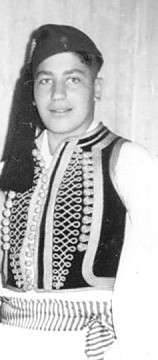
[Capitol Café 1937. Spiro Angelo Dendrinos centre and Peter Dionysos Manias behind till.]
Harry prefers not to enter the controversy (put two Greeks together and you get three arguments, as they say in the classics) and simply notes that they continue to make all their own cakes, pastry, chocolates, ice cream and assorted confectionery, and employ a permanent staff of 12.
Out the back in the Department of Philosophy he also observes that the usual crowd of SP bookies and card sharks has assembled to argue politics and the state of the nation, a peculiar Greek kafeneion custom that never caught on with the locals, the pubs' public bars remaining the favoured forum for debating. But our spy moves on, having wised up after donating his wages on too many occasions.
However, he can see that dining out in Lismore is rapidly evolving away from the traditional sit-down three-course meal and conventional menu, and the Capitol, with its elaborate kitchen, bakery department, counters and large staff, is heading for white elephant status. And sure enough within a couple of years it was reduced to light refreshments and retailing of its cakes and pastries, and by 1960 was occupied by an electrical retailer.
The Vogue Milk Bar (41 Molesworth)
Before continuing down the inside of the block, Harry veers across the road to call in on Jack Kery Bavea and finds him doing a relaxed trade between theatre showings. Jack and his bride Patra (nee Dermati of Moree) had come to town from Tingha in 1946 and joined Nick Crones in partnership upon acquiring Angelo Crethar’s shares, becoming sole owners a year or so later when Nick moved around to Magellan Street to open ‘The New City Milk Bar’. Jack is the son of Kyriakos Ioannis Baveas, the warrior who served in both the Balkan Wars and WW1 and, with his brother-in-law, the late Lismore identity, Theo George Fardouly, amongst the pre WW1 Kytherian pioneers out west.
Harry registers less passing trade on the outside of the block, although Jack’s elaborate sandwiches, salads and sundaes attract loyal lunch time customers from the many offices in the vicinity, while the matinee and evening theatre crowds continue to pull a quid. The theatre was given an extensive makeover after the 1954 flood, adding a very plush dress circle where Jack installed another milkbar as a more convenient spot to provision his lolly boys who wandered the theatre, one of whom is none other than our Harry, a well-built deterrent to delinquent behaviour.
By the mid 60s the popularity of theatre going was well and truly on the wane, prompting him to sell up and retreat to Sydney in 1966, leaving the shop in the hands of his son-in-law, Charles Nick Feros, who followed him to Sydney about 6mths later upon finding that the trade had continued to deteriorate. Peter Cassis, nephew of the various Cassis in businesses elsewhere in town, managed to squeeze some life out of it for another 18mths, after which the place folded as a catering outlet.
[And Jack’s brother, Nick Bavea, also found the north coast café game hard going by the mid 60s, managing to dispose of his ‘Black & White Café’ in Casino a couple years later to follow him to Sydney, marking the final phase of the exodus from the region. Jack’s son Kerry returned to town in 1972 to set up a dental practice, continuing the new trend in the nature of 2nd generation employment.]
The Vogue, an airy open-plan affair scoring a 7* in the milk bar category, went through a number of purifications until born again as a real estate office, while the Christian Life Centre now finds the theatre next door ideal for evangelical gatherings.
[Digression: At a press conference a few years ago, Paul Panaretto, owner of the El Gronda Café next to the theatre in Casino, was asked: ‘And the question on everyone’s lips Paul is how you managed to serve a hundred or so screaming kids during the 20 minute interval at the Saturday afternoon Matinee’
Paul: ‘Anticipation. We more or less knew what they’d order and had drinks already poured, ice creams made up.....’
Interjector: ‘But what about little buggers like me who wanted a penny’s worth of assorted lollies and took forever to choose which ones?’
Paul: ‘You little *%#!/&!*#x$%.......’.]
The Tudor Café (106 Molesworth)
Harry resumes his walkabout and returns to the main drag to run an eye over the Tudor, which is doing a busy trade as usual under the steady hand of Norman Contojohn, who had recently taken command from his father Peter, another non-Kytherian upstart from the Ipiros region of northern Greece. The teenaged Peter had landed pre WW1 and spent many years in Western Australia until coming to this region looking for work during the Depression years. By the mid 30s he was back in the café game with a shop at Glen Innes, but in the early war years came to Lismore to acquire the business of ‘Coroneo & Panaretto’ after the enlistment of Jack Victor Panaretto.
The site had been a dedicated café outlet since 1927 when Paul Coronakes of Woodlark Street rolled out his second business, giving it a makeover in 1930 and 3yrs later passing the place to the Jones family. They in turn passed it to the puzzling Greek partnership in the late 30s, just after the 1937 reconstruction that gave the place the distinctive mock-Tudor look and new mod cons that brought it into the big league. It’s understood Denny Panaretto was the gaffer, leaving his brother Jack with day-to-day management, while the silent Coroneo half remains elusive; either Nick Angelo Crones or Peter and/or Leo John Coroneos. The business is believed to have traded as Coroneo & Contojohn for a short period until Peter Contojohn took full command.
In early 1945 the Contojohns were amongst those who chose to close their businesses after they became too difficult to run through increasing rationing, quotas and lack of staff. Following the mid year flood, the worst in Lismore’s history at the time, they acquired portion of the shop next door and carried out a major overhaul, relaunching in early 1946 with the name ‘Tudor Café’ immortalised on the footpath in mosaic tiles. It now had a substantial bakery amongst other innovations, earning a 7+ on the posh scale, but, not to rest on their laurels, in 1948 they acquired the freehold and continued fine tuning until late 1956 when Norm, an accomplished pastry cook, split the shop and business and passed the café to John Carblis, while he concentrated on the bakery and retailing of his cakes and pastries.
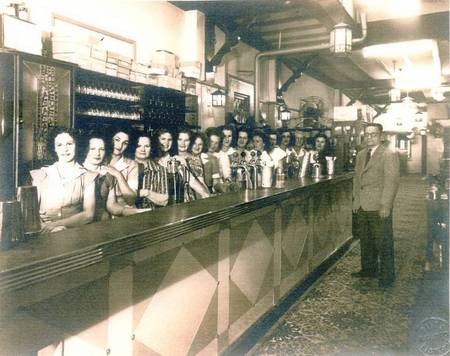
[Tudor Café 1948. Peter Contojohn (Kountogiannis) in front of bar and daughter Daisy leading large staff contingent.]
John Carblis (Zois Karambalis) had Lismore gobsmacked when he opened with large adverts proclaiming himself as ‘Australia’s Most Celebrated Chef’ and presenting a menu featuring some mysterious stuff called ‘continental foods.’ He was a teenager when he landed from Lefkadi, just north of Ithaca, in the 1930s, quickly mastering the mysteries of catering at Lennons Hotel in Brisbane. He was still at Lennons when he enlisted in 1942 and was promptly seconded onto General MacArthur’s staff, becoming the General’s personal chef for the duration of the American presence. Lennons, where MacArthur and his senior officers had requisitioned the entire top floor, was the scene of many lavish functions for a stream of VIPS, (Admiral Nimitz, Eleanor Roosevelt, Gary Cooper, …), all overseen by John. Post war he became Head Chef at the hotel and in 1955 was appointed as the first catering manager of the new ultra-modern Lennons Broadbeach, from where the cunning Norm somehow managed to attract him to Lismore.
John was very busy indeed, taking on the catering contract of the Canberra Hotel across the road as well as provisioning and cooking for weddings, parties, balls and banquets at venues all over town. Alas, the advent of the clubs and the drying up of the café trade, coupled with Lismore’s resistance to newfangled cooking ideas and ingredients, saw him return to Broadbeach in 1959. In the early 1960s he moved to Sydney and had a number of ventures over the following years, including Head Chef at the Royal Sydney Yacht Squadron, the face of Sunbeam Frypans and a stint in New Guinea, before his swansong as a catering instructor at TAFE in the early 1980s. (And for chroniclers of cooking: Sunbeam introduced its classic electric frypan in 1956, the things quickly becoming essential items in every home and café kitchen.)
[John’s frustration at Lismore’s reluctance to be culinary curious is echoed in the sentiments of Arthur Cassis, an earlier cook at the Capitol. In the late 1950s, after a long stint of banana growing at Mullumbimby, he returned to the café game as a chef at one of the new trendy restaurants at Surfers Paradise. A year or so later he went to the Austral at Murbah with novel ideas on continental cooking and managed to convince Con Vlismas to add a few exotic dishes to the menu. But the Murbahians, like the Lismoriots, wouldn’t take the risk and stuck with steakeneggs, causing him to comment that the town was ‘50 miles away and 50 years behind’!
And by the bye: Surfers was one of the epicentres of Australian social change. The Windjammer was established in 1948 and led the way in casual al fresco dining, cosmopolitan atmosphere, nightclub entertainment and exotic menus. Sophistication extended to defying Queensland laws and serving booze with meals, for which they were sprung and fined on numerous occasions. The Flamingo, opened by the Dutchman Marny de Vires in 1954, continued the trend and took dining way up-market. By 1980, when Lismore was just awakening from its hibernation, Surfers and environs had over 300 restaurants, amongst the best in the country.]
In the meantime Norm installed a series of managers at the Tudor until the mid 1960s when he again took charge of the café, reorientating the whole shop to fast food and confectionery retailing and running a lean operation until 1972 when a major reconstruction created the Lismore Arcade. The bakery was consigned to oblivion and the café reduced in size, introducing the very latest takeaway foodology fashions, while a fun parlour was created upstairs, offering pinball machines and billiard tables to lads misspending their youth, the place folding in the late 70s after things got out of hand.
He started a billiard table retailing and installation operation in the last shop in the arcade, leaving the cafe in the hands of a series of supervisors, but remaining overseer into the 1990s when, at age 75, he finally leased the place, and, in Dec2004, finally sold the building to Lismore’s latest property tycoon, Peter Coronakes, who promptly closed it down for another major overhaul.
At the time of closure the place was known as ‘Food for Thought’ and into al fresco, catering to people-watchers with a penchant for footpath coffee sipping. It’s now home to Subway, the sandwich specialists, currently the fastest growing franchise chain taking over the world. Peter has left the original footpath name unmolested and has himself opened a coffee shop in the revitalised arcade. And the shambles upstairs is once again devoted to professional offices.
The Star Court Kiosk (122-136 Molesworth)
The inspection tour now takes Harry down the Star Court Arcade where George and Mary Black are catering to loyal customers. This cafe was created in 1930 by the partnership of Angelo Victor Crethar and Greg Jacob Londy when they partitioned off a section of the theatre forecourt, using the counter as the defining barrier to the open-plan arcade. It’s bedlam and standing room only when the theatre is in session but otherwise a more genteel pace reigns, with passing shoppers enjoying a sandwich and cuppa tea at the half dozen scattered tables and chairs.
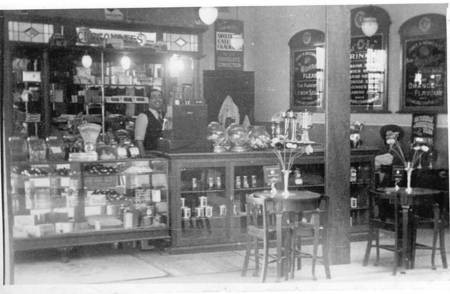
[Star Court Kiosk 1942. Anargyros (Eric) Victor Crethar behind counter.]
The Kiosk, then known as the ‘Star Court Kandy Shop’, was acquired by Peter Nick Crethary in 1942 after Greg Londy decided he’d had enough of generating profits for Angelo and branched out on his own at Casino. Business boomed when Peter installed his stunning daughters, Matina and Mary (Muriunthi), behind the counter, and American soldiers came from camps all over the place to show their approval. In 1944 the bane of everyone’s life, quotas, rationing and lack of staff, forced Peter to scale back his Monterey Café in Keen Street and consolidate at the Star Court, which he owned until his death in 1958, although Mary and her new husband, George John Black (Mavromatis) of Casino, had taken full command by 1955, at which time the Kiosk was only opened for the theatre sessions. Mary and George transformed the place, opening all day and adding toasted sandwiches and the like to the menu, continuing to run it until 1965, by which time they’d also added Angelo Crethar’s original café around the corner in Molesworth Street to the management workload.
The place remains in business, catering to the crowds attracted to the occasional avant guard film showing, concerts and live plays, as well as a lingering daytime trade from old loyal customers. Every schoolkid smaller than counter height, if he survived being trampled to death, remembers the disappointment of returning empty handed to the theatre after half-time without Jaffas to hurl at the bad guys on the screen. In revenge, the judges have awarded a 6*. (In comparing the Star Court and the Vogue, the cafes mirrored the theatres. The Vogue was a classier cinema than the Star, with prices to match, and the Vogue Milk Bar was a more profitable concern than the Star Court Kiosk.)
In the projection box at the theatre was Charlie Anthony Sourry, who had come down from Brisbane around 1940, married his childhood sweetheart, Maria Nick Terakes, in 1942 then went off for a distinguished war service. Post war he returned to the theatre, but down the line started his own carrier business, via a few years as a fruiterer and shop-keeper. He was a sports nut, becoming a life member of the Norths Cricket Club, a life member of the Lismore Soccer Referees Association and a life member of the Group One Rugby League Association. Maria was ‘Lismore Citizen of the Year’ in 2005.
And that harrowing ahhhhhh… sound Harry can hear is coming from the dental chair of Charlie’s old Brisbane schoolmate, Con Minas Tsicleas, with rooms above the arcade. Con is the most terrifying person in Lismore, with a range of diabolical instruments that caused grown men to weep, let alone scaring the daylights out of the 50s generation of schoolkids (and generating phone threats diverted to the terrified Tsicalas family.) He had brought his implements to town in the early 50s and initially had a practice in Molesworth Street before taking up long term residence in the Arcade. He now enjoys sifting sand through his toes in retirement at Ballina, reminiscing on the old times when his hands wielded absolute power. Grrrrrrr….
But Harry quickly puts his hands over his ears and looks towards the elaborate front entrance to the theatre’s stalls and sees the future. The death of the movies occurred quickly after introduction of TV, the stalls being knocked out to extend the arcade through to Carrington Lane, leaving the dress circle above. One of the new shops was taken up by the Ithacan Peter Manias and dubbed ‘The My Fair Lady Coffee Shop.’
My Fair Lady Coffee Shop (Star Court Arcade)
Peter Manias went against the Greek trend and opened his shop in the arcade around 1962, quickly gaining a reputation for his tasty pastry and providing Con Tsikleas with a steady stream of victims. He had landed in 1922 and spent a few years with Con Vlismas, the master caterer of Murwillumbah, until linking up with Spiro Dendrinos to acquire the Vlismas Bros ‘Capitol Café’ in 1937. His brothers Gerry and Leo subsequently joined the partnership, while Dendrinos, like most Ithacans, went into the banana business in 1945. Leo moved to Newcastle in 1955, leaving Peter to sense the end of the elaborate café and recognize simplicity as the future direction of catering. After selling out of the Capitol he marked time for a year or so planning his new lean venture, which became a model for others, including the ever-observant Harry Crethar, who concurs with the judges that a 7* in the popularity category is fair.
Peter survived successfully into the 1970s when he moved to ‘Seaworld’ on the Gold Coast to apply his formula in that burgeoning market, while his old shop has remained trading to this day.
Harry emerges back into the sunlight of Molesworth, but before proceeding onto the salubrious café of his employer, his uncle Angelo Crethar, again decides to cross the road to see whether there are any new developments at the Golden Globe, the recently vacated fiefdom of his namesake, ‘Old Harry’ Crethar.
The Golden Globe Café (89 Molesworth)
The Globe had been created in the Girls Club Building on the corner of Green Lane in late 1927, on the northern side of the New England Motor Co’s Booking Office and Transit Lounge. Around the same time Athena Andrulakis, perhaps seeking some of the passenger trade as well as a bit of pub patronage, also opened a Fish Shop at number 85, a couple of doors north of the lane and a couple of doors south of the Canberra Hotel. She finally retired from the game in 1930, aged 64, passing the place to a fruiterer who installed a posh soda fountain and traded for a couple of years until it came into the hands of Host Criss who resurrected the deep fryer. The place earned a reputation as a high-class fish shop, allegedly the best in town, but by the late 1930s was occupied by Walz drycleaning business, at which time the Daffodil Tea Rooms opened on the southern side of the bus terminus and joined the Globe in servicing the increasing passenger traffic. The terminal was very busy indeed, acting as the agency for a number of bus companies carting passengers to and from towns and villages all over the place.
The Globe thrived through the region’s ‘Claytons Depression’, ‘Great Depression’ and WW2 (despite bus services curtailed due petrol rationing) and was in the hands of May Morris when acquired by Harry Jim Crethar in 1945 after he’d sold out of his Regent café in Keen Street. Harry’s selling motives were much the same as others at the time; fed up with trying to run a large establishment without staff and hampered by rationing, he figured a hassle-free smaller affair would suit him at that stage of life.
By 1946 things were really looking up with the returned warriors all over the place, one of whom was his ex Regent employee, Spiro Tsicalas, who resumed employment with Harry but, in a fit of pique in 1948, marched across the road to work for Angelo after Harry welshed on his partnership deal (thank God). Harry’s nephew, Theo George Poulos, went out in sympathy and also joined Angelo, leaving his mother, Harry’s sister Zafiro, to remain loyal. Following her death in mid 1952 Harry decided he’d had enough after 30yrs in the game and retired to Sawtell, where he died in 1956, at the same time the New England Motor Company moved its expanding enterprise a long way south on Molesworth.
The Globe suffered a dramatic drop in business and, being on the outside of the block with the decreasing passing traffic increasingly reluctant to dip deep into pockets, the place subsequently closed and the site redeveloped, leaving the judges to award a posthumous 6.
Before proceeding back to the main drag the budding capitalist gives the finger to the committed socialist standing outside his drycleaning business.
City Dry Cleaners (101 Molesworth)
Lou Katsaros came to Lismore around 1930 to acquire a confectionery business, but didn’t do so well in those dreadful Depression years that hardened his political stance as he watched Lismore become home to the largest shantytown for the displaced and unemployed in northern NSW. While things started to come good by the mid 30s he remained a paid-up lefty and enlightened employer upon becoming proprietor of City Dry Cleaners in the late 30s, giving some socialist competition to Walz 30yds away.
He and his mates added a bit of spice to Lismore’s political life, although they had buckleys in this stronghold of the Country Party, paradoxically a strange amalgam of social conservatives and economic socialists like the Labour Party. At its peak the local branch of the Trades and Labour Council only had about 15 members and their efforts to unionise Lismore’s workforce were a cause for much mirth. In mid 1947, after the introduction of the 40hr week, they tried to form a local branch of the Shop Assistants Union to start agitating for a five day working week, but only managed to attract 6 out of Lismore’s estimated 800 shop employees to the meeting. Nevertheless, the shop assistants benefited from the union efforts later in the year when they won a new industrial award of £7/2/- for males and £4/10/6 for females.
The Labour Council got the last laugh when they demonstrated entrepreneurial capitalist flair in convincing a local bank manager to give them money to buy an old house in Keen Street as a clubhouse, ‘The Workers Club’, which, after the introduction of poker machines in 1956, went on to become the largest and wealthiest club in NSW. Lou never saw any of this however, as shortly after the finger he sold up and joined his fellow travellers at Wollongong.
On the way back across the road Harry can just see the front of Jack Hamilton’s popular pie cart, aka the Caravan Café, at the intersection of Molesworth and Magellan, recently relocated from its old spot at the corner of Carrington and Magellan. His trade peaked around the late 50s, allegedly selling 80doz pies on a Saturday night to the boppers at the nearby Riviera dance hall, but thereafter rapidly falling away as the Riv became a victim of the club scene. The tradition is still being maintained by Ridgy Didgy Pies, operating out of an elaborate semi-trailer sized caravan adjacent to the old Post Office in Magellan, and still doing a roaring trade to the chagrin of the other Magellan caterers. (Never get between a Lismoriote and a pie.)
Crethar’s Air-Conditioned Café (142 Molesworth)
‘Young Harry’, like a lot of other die-hard devotees around town, still considers that the ‘Air-Conditioned’ should share the podium with the Capitol at the awards’ ceremony for Lismore’s premier restaurant, retaining it’s 9 on the Posh Scale, inclusive of a bonus point for proprietor’s star quality. But, even so, Harry notes the diminishing patronage of the grand dining room beyond, while the lighter refreshments at the front continue to bubble along.
The ‘Air-Conditioned’ was the culmination of Angelo Victor Crethar’s long marathon starting in Ballina in 1911. He and his brother Menus inherited the business of their brother Harry in 1919, although Angelo gained control of the stove while Menus was running around arguing with Turks and, later closer to home, café competitors in Tamworth and Brisbane. He was amongst the first to appreciate the simplicity of the new sundae-shops rapidly gaining in popularity, doing away with the large capital expenditure and heavy manpower requirements of the traditional café/restaurant. Mixing a concoction at the counter and serving it with Peach Melba, or similar confection, sure beat the hell out of sweating away in the elaborate kitchen in the back. Over the next few years he opened the things everywhere, leaving them in the hands of managers after his initial purchase and makeover.
His move to Lismore in 1923 was probably prompted by his canny timing ability, sensing that the decline in Ballina’s growth rate was permanent, although the competition was also getting a little more aggressive. Said one Ballina rival in his 1923 adverts: Australian’s help Australians…. Lattimores are Australian, so come to Lattimores…. As elsewhere, the Greeks were giving their Australian competitors a serious headache, as Angelo found upon arrival in Lismore. He kept a low profile during the ‘Great Barrow Wars,’ wisely concentrating on perfecting his sundae-shop formula and staying clear of fruit retailing.
His first acquisition in Woodlark Street, the ex ‘Busy Bee Café’ of George Patrinos, late of Brunswick Heads, was quickly revamped into ‘Crethar’s Sundae Shop’. In 1926 came the purchase of a tea room business in Molesworth, the site of John Zervothakis’s ‘American Café’ 20yrs earlier, followed by a shop in Keen in 1927, another in Woodlark in 1929, the Star Court in 1930 and the Vogue in 1936, all left in the hands of managers or pseudo partners while he based himself at the Molesworth enterprise and carried out a series of minor upgrades, and, would you believe, employing a genuine Michelin-starred French pastry cook wearing one of those funny hats that touched the ceiling. By 1932 he was claiming his shop was …one of the most artistically furnished, brilliantly lighted, and best equipped shops outside Sydney… the ‘made-to-day’ chocolates and candies find ready purchasers…. Through to the Depression and beyond he was shrewd enough to stick to his simplicity recipe, but in 1935 when he sensed those ‘happy days were here again’ he jumped the gun on his dithering competitors and again cornered the upmarket niche, left vacant after the demise of Theo Fardouly’s elaborate Olympia a couple of doors down and before the second coming of the Capitol. He followed the Olympia formula, successfully combining both extremes of the catering scale with a ritzy establishment on top and light refreshments at street level, but with all the latest mod cons that Theo’s pre WW1 era establishment could never incorporate.
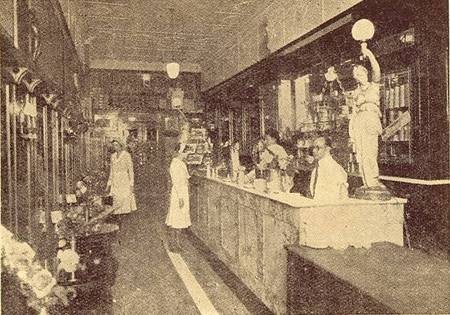
[Crethar’s Sundae Shop 1932. Angelo beneath the lady with the lamp.]
Until his next masterstroke, the introduction of air-conditioning in 1939, the upstairs area, reached by a spacious internal staircase, remained the posh side of the business, serviced by a dumb waiter from the kitchen below. But this new touch of modernity consumed a fair chunk of space, so the downstairs area at the rear was redeveloped, with the bakery re-established on top, relegating upstairs to special catering occasions, such as weddings and banquets, although remaining the favoured venue for the weekly meetings of his fellow Rotarians. The front layout remained much the same as the sundae-shop days, with the bar on one side of the entrance and a series of two-seater cubicles down the other, the walkway between the two leading to the larger dining room beyond.
His shop was the region’s first air-conditioned business, let alone the first restaurant, to offer such an innovation. It drew crowds that queued halfway down the street during summer awaiting Angelo’s admittance wave, signalling who was ‘in’ and who was ‘out’, a ready indicator to where he thought you ranked in Lismore’s social structure. A subtle marketing strategy was to price the produce in his window display, elegantly arranged fruit, cakes, pastries and other enticing confections, slightly above that of his competitors, guaranteeing that the pennywise never entered the place. In 1946 he was granted the region’s first restaurant liquor licence, although a wine cellar was never created; the bit of paper merely legitimatising the consumption of ‘light wines and malted liqueurs’ at the infrequent functions on top and the odd patron way ahead of the BYO trend below.
While losing heart after the massive destruction of the ’54 flood, which broke the ’45 record, he hung on till 1956 when he again demonstrated his canny timing instincts, selling up just before the accelerated decline in his style of dining out. The place became Lismore’s first Chinese restaurant, the Tung Kong, but the locals still weren’t ready for this type of colourful cuisine and it folded in 1962. George and Mary Black then returned a Greek presence, offering the familiar Australian fare, albeit in a cheaper and less elaborate form to Angelo’s package, until they too found trading difficult and moved to Ballina in 1965. The site is now home to Pines Newsagency.
Final word from Sandy Robertson in his book‘End of an Era; The Changing Face of Lismore’: … Mr Crethar, himself always dressed in an immaculate suit, complete with carnation in his buttonhole, supervised everything from the soda fountain, milk bar, and restaurant right down to the kitchen. …The waitresses were all in uniform, white aprons and headbands….
I can remember when the postwar influx of migrants started arriving, it was discouraged by the government to refer to them as ‘wogs’ or other unsavoury terms. They were to be called ‘New Australians.’ Angelo’s reaction was, “What’s this bleddy New Australian business? I’ve been here for thirty years and I’m still a bleedy dago!”
But our New Australian Harry, winner of many observer-of-the-day awards, foresaw ‘the changing face of Lismore’ catering and was already framing his own formula. And that prescient talent gives him another glimpse into the future as he passes Pennys, one of the smaller old-style department stores.
Warina Walk Arcade (154-158 Molesworth)
Pennys, like most of its elaborate competitors, folded in the 60s, all falling like nine-pins together and all shedding employees in droves, some after forty or more years of loyal service. It was a dismal blot on Lismore’s employment history and Lou Katsaros would’ve been depressed.
Nevertheless, things move on and the site was redeveloped as Warina Walk Arcade in 1970. And first on the scene was none other than our Harry, putting a deposit down to acquire a shop within the precinct and create ‘The Colonial Bar,’ ‘specialist in home style cooking’. However, outfitting the place drains resources from the ballooning business of his ‘Wonder Bar’ and he finds himself overextended. Still, being a man of resolute will (he’d never admit to stubbornness), he perseveres for a couple of years until relieved to pass the place to his mother-in-law, Matina King (nee Crethary and Coronakes), and returns to recommit to his first love. Matina carried on for a year or so until the music stopped and there was a reshuffling of chairs; she taking over her sister Mary’s shop in Ballina and Mary returning to Lismore to take on the management of the exclusive Lismore Club, Lismore’s answer to the Melbourne Club (think movers and shakers, black balls, etc.)
The Colonial remains in business, catering to an older and devoted niche clientele.
Harry is jolted out of his reverie and continues around ‘AGR’s Corner’ (Lismore’s favoured rendezvous point and Sandy Robertson’s fiefdom) and into Magellan Street to see what Peter Feros can offer.
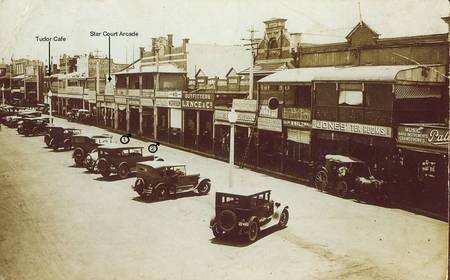
Molesworth Street 1930
Jones’ Tea Rooms was the original home of the Queen City Refreshment Rooms, opened by Alderman John I. Smith in 1896 and passed to Walter Gray in 1924. Gray passed it to Fred and Grace Jones 18mths later and moved further north on Molesworth to take over the MG Refreshment Rooms and create the Elite Cafe, which he passed to the Vlismas Bros in 1929.
The Tudor was a saddler’s shop until converted into a café in 1927 by Paul Coronakes who passed it to the Jones’ in 1933 after their shop was absorbed in the construction of Penny’s Department Store.
(1) was the Olympia Café until becoming home to Lang’s Shoe Shop in 1929, but Theo Fardouly and family continued to live upstairs for some time.
(2) is Crethar’s Sundae Shop, established by Angelo Crethar in 1926 upon taking over the Tea Room business of Sackett & Howard, who had in turn taken over from John Zervothakis in 1908. In 1935 Angelo added a second storey and absorbed portion of the shop next door.